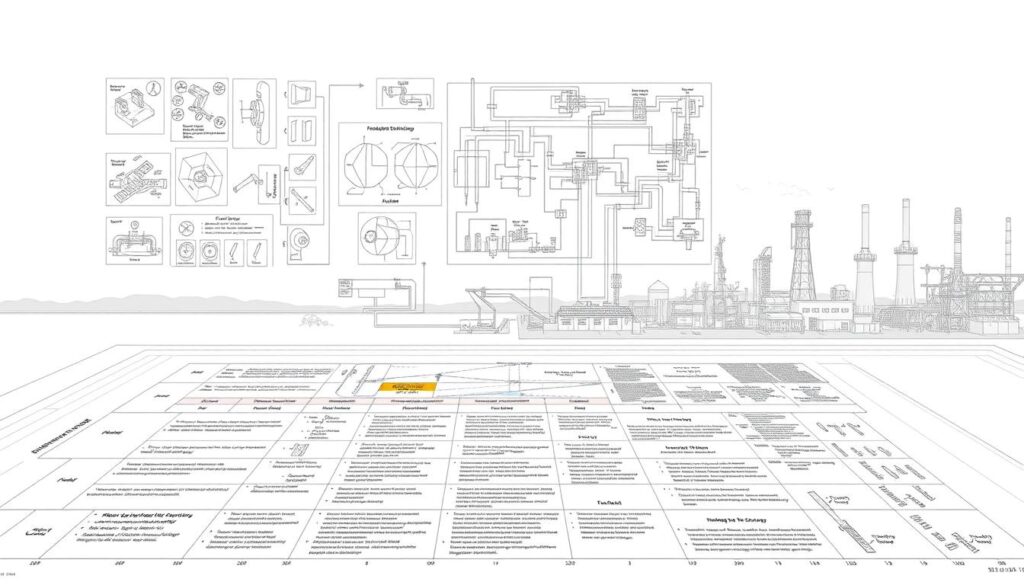The importance of risk assessment and quality control in engineering projects cannot be overstated. According to the International Council for Harmonisation of Technical Requirements for Pharmaceuticals for Human Use (ICH), quality risk management is based on two primary principles: it should be grounded in scientific knowledge, and the level of effort, formality, and documentation should be commensurate with the risk level.
Effective quality assurance in engineering ensures the safety, efficiency, and cost-effectiveness of projects. For a deeper understanding of project risk assessment, exploring resources such as Understanding Project Risk Assessment in Engineering can provide valuable insights into best practices.
Key Takeaways
- Quality risk management should be based on scientific knowledge.
- The level of effort in risk management should be commensurate with the risk level.
- Effective risk assessment ensures project safety and efficiency.
- Quality control is crucial for the cost-effectiveness of engineering projects.
- Understanding risk assessment best practices is essential for successful project management.
Understanding Engineering Risk Assessment
Risk assessment plays a pivotal role in the engineering sector by mitigating potential hazards and ensuring project success. It is an integral part of risk management in engineering, helping to identify, analyze, and mitigate risks that could impact project outcomes.
What is Engineering Risk Assessment?
Engineering risk assessment is a systematic process used to identify, evaluate, and mitigate risks associated with engineering projects. It involves a thorough analysis of potential hazards, their likelihood, and their potential impact on the project. By understanding these risks, engineers can develop effective engineering risk mitigation strategies to minimize their effects.
The process typically includes:
- Identifying potential risks and hazards
- Analyzing the likelihood and potential impact of these risks
- Evaluating the risks to determine their significance
- Developing strategies to mitigate or manage the identified risks
Importance of Risk Assessment in Engineering
The importance of engineering risk evaluation cannot be overstated. It is crucial for ensuring the success and viability of engineering projects. By conducting thorough risk assessments, engineers can:
- Enhance project safety by identifying and mitigating potential hazards
- Reduce costs by minimizing the impact of unforeseen events
- Improve project planning and decision-making
- Ensure compliance with regulatory standards and requirements
As noted by industry experts, “Risk assessment is not just a regulatory requirement; it’s a vital tool for ensuring the integrity and success of engineering projects.” Effective risk assessment and management are key to delivering projects on time, within budget, and to the required quality standards.
Components of Risk Assessment

Effective engineering risk assessment hinges on understanding its core components, which include identifying risks, analyzing their impact, and evaluating their significance. These elements work together to provide a comprehensive understanding of potential risks in engineering projects.
Risk Identification
Risk identification is the first step in the risk assessment process, involving the systematic identification of potential risks that could impact a project. This includes considering various factors such as design flaws, material failures, and external factors like environmental conditions. For more information on how risk identification fits into overall project management, visit Civil Engineering in Project Management.
Risk Analysis
Once risks are identified, risk analysis is conducted to assess the likelihood and potential impact of these risks. This involves both qualitative and quantitative techniques to understand the severity of the risks and prioritize them accordingly. Techniques such as Failure Mode and Effects Analysis (FMEA) are commonly used in this phase.
Risk Evaluation
The final component is risk evaluation, where the analyzed risks are evaluated against certain criteria to determine their acceptability. This step involves comparing the assessed risks against established risk tolerance thresholds and deciding on appropriate mitigation strategies. Effective risk evaluation is crucial for ensuring the reliability and safety of engineering projects, aligning with quality management systems in engineering.
By understanding and implementing these components of risk assessment, engineers can enhance engineering reliability analysis and overall project quality, ultimately contributing to successful project outcomes.
Common Methods for Risk Assessment
Effective risk management in engineering relies on robust risk assessment methods, which are categorized into qualitative and quantitative techniques. These methods enable engineers to identify, analyze, and mitigate risks associated with engineering projects.
Qualitative Risk Assessment Techniques
Qualitative risk assessment techniques involve subjective judgments to evaluate risks. These methods are often used when there is limited data available or when a quick assessment is required. Qualitative risk assessment is beneficial for identifying potential risks and prioritizing them based on their likelihood and impact.
Some common qualitative risk assessment techniques include:
- Risk matrices
- SWOT analysis
- Expert judgment
For instance, a risk assessment might use a risk matrix to categorize risks based on their probability and potential impact, allowing for a visual representation of the risks.
Quantitative Risk Assessment Techniques
Quantitative risk assessment techniques, on the other hand, involve numerical data to evaluate risks. These methods provide a more precise estimation of risks and are often used for complex engineering projects. Quantitative risk assessment involves statistical analysis and modeling to predict the likelihood and potential impact of risks.
Some common quantitative risk assessment techniques include:
- Monte Carlo simulations
- Sensitivity analysis
- Decision tree analysis
For example, a quantitative risk assessment might use Monte Carlo simulations to model different scenarios and predict the potential outcomes, enabling engineers to make informed decisions.
Both qualitative and quantitative risk assessment techniques have their advantages and disadvantages. The choice of technique depends on the specific requirements of the engineering project, including the availability of data and the complexity of the risks involved.
Engineering Quality Control Explained

The implementation of robust engineering quality control measures is essential for detecting and correcting defects in engineering projects. Quality control is a systematic approach to ensuring that engineering projects meet the required standards and specifications.
Definition of Engineering Quality Control
Engineering quality control refers to the processes and procedures used to ensure that engineering projects are designed, constructed, and delivered to meet the specified requirements and standards. It involves a series of checks and balances to verify that the project is executed as planned.
Effective quality assurance in engineering involves the use of various tools and techniques to monitor and control the quality of the project. This includes inspections, testing, and the implementation of corrective actions when necessary.
The Role of Quality Control in Engineering Projects
The role of engineering quality control is multifaceted. It not only ensures that the project meets the required standards but also helps in identifying and mitigating risks. By implementing quality control measures, engineers can detect potential issues early on, reducing the likelihood of costly rework or project delays.
For more information on the objectives of engineering project management, which include quality control, visit Objectives of Engineering Project Management.
By integrating engineering quality assurance practices into the project management process, engineers can ensure that their projects are completed on time, within budget, and to the required quality standards.
Importance of Quality Control in Engineering
In the engineering sector, quality control plays a vital role in enhancing product reliability and reducing unnecessary costs. Quality control procedures in engineering are designed to ensure that products meet specific standards and requirements, thereby improving overall quality.
Effective quality control is not just about inspecting products; it’s about implementing a comprehensive quality management system that encompasses every stage of the production process. This includes risk identification, analysis, and mitigation, ensuring that potential issues are addressed before they become major problems.
Enhancing Product Reliability
One of the primary benefits of quality control is the enhancement of product reliability. By implementing rigorous testing and inspection protocols, engineers can identify and rectify defects early in the production process. This not only improves the quality of the final product but also reduces the likelihood of costly rework or product failures.
“Quality is not just about meeting standards; it’s about exceeding customer expectations.”
For instance, in the aerospace industry, quality control measures are critical to ensuring the reliability and performance of aircraft components. By adhering to stringent quality standards, manufacturers can minimize the risk of component failure, thereby enhancing overall safety.
Reducing Costs and Waste
Quality control also plays a significant role in reducing costs and waste in engineering projects. By identifying defects and inefficiencies early on, companies can avoid costly rework and minimize waste. This not only improves the bottom line but also contributes to more sustainable practices.
| Benefits of Quality Control | Description | Impact |
|---|---|---|
| Enhanced Product Reliability | Rigorous testing and inspection protocols | Improved product quality and safety |
| Reduced Costs | Early defect detection and correction | Minimized rework and waste |
| Increased Efficiency | Streamlined production processes | Improved productivity and reduced lead times |
As illustrated in the table, effective quality control measures can have a significant impact on engineering projects, from enhancing product reliability to reducing costs and waste.
By integrating quality control into every stage of the engineering process, companies can ensure that their products meet the highest standards of quality and reliability. This not only enhances customer satisfaction but also contributes to the long-term success of the organization.
Key Principles of Quality Control

Quality control in engineering is not just a process, but a culture that thrives on certain foundational principles. At its core, quality control is about ensuring that engineering projects meet the required standards and specifications, thereby guaranteeing the delivery of high-quality outcomes.
Two of the most critical principles underpinning quality control are continuous improvement and stakeholder engagement. Continuous improvement is about regularly assessing and refining processes to enhance efficiency and product quality. It’s a proactive approach that anticipates potential issues before they arise, thereby minimizing risks and optimizing project outcomes.
Continuous Improvement
Continuous improvement is a mindset that encourages ongoing learning and adaptation. In the context of engineering quality control, it involves regularly reviewing project processes, identifying areas for improvement, and implementing changes to enhance overall quality.
“The key to successful quality control is not just meeting the standards but continuously striving to exceed them.”
A key aspect of continuous improvement is the use of data and analytics to inform decision-making. By leveraging data, engineering teams can identify trends, pinpoint inefficiencies, and develop targeted strategies to address these issues.
| Aspect | Traditional Approach | Continuous Improvement Approach |
|---|---|---|
| Process Review | Periodic | Ongoing |
| Issue Resolution | Reactive | Proactive |
| Data Usage | Limited | Extensive |
Stakeholder Engagement
Stakeholder engagement is another vital principle of quality control. It involves actively communicating with and involving all parties who have a vested interest in the project’s outcome. This includes not just project team members but also clients, suppliers, and end-users.
Effective stakeholder engagement ensures that everyone is aligned with the project’s quality objectives and is working towards the same goals. It fosters a collaborative environment where feedback is encouraged, and concerns are addressed promptly.
- Identify stakeholders early in the project lifecycle.
- Establish clear communication channels.
- Foster a culture of transparency and feedback.
By embracing continuous improvement and stakeholder engagement, engineering projects can significantly enhance their quality control measures, leading to better outcomes and higher client satisfaction.
Quality Control Tools and Techniques
To maintain high-quality standards, engineering projects employ a range of quality control tools and techniques. These methodologies are crucial for detecting and correcting defects, thereby ensuring the reliability and performance of the final product.
Statistical Process Control (SPC) is one such technique that involves the use of statistical methods to monitor and control processes. By analyzing data from the production process, SPC helps in identifying variations that could lead to defects. This proactive approach enables engineers to make adjustments before defects occur, thus enhancing product quality.
Statistical Process Control (SPC)
SPC utilizes control charts to track process performance over time. These charts provide a visual representation of the process data, making it easier to detect any deviations from the norm. As Dr. W. Edwards Deming, a pioneer in quality control, once said, “Without data, you’re just another person with an opinion.” SPC relies on data to make informed decisions about process adjustments.
A key benefit of SPC is its ability to distinguish between common cause variation and special cause variation. Common cause variation is inherent in the process, while special cause variation is due to external factors. By identifying the type of variation, engineers can take appropriate actions to correct the process.
Failure Mode and Effects Analysis (FMEA)
Failure Mode and Effects Analysis (FMEA) is another critical tool used in quality control. FMEA is a systematic approach for evaluating processes to identify where and how they might fail and assessing the relative impact of different failures, in order to identify the parts of the process that are most in need of change.
FMEA involves a thorough analysis of potential failure modes, their causes, and their effects on the system or product. By prioritizing failure modes based on their risk, engineers can focus on mitigating the most critical risks first. As noted by quality control experts, “FMEA is a powerful tool for evaluating the risk associated with potential failures and for identifying actions that could reduce this risk.”
In conclusion, quality control tools and techniques like SPC and FMEA are essential for maintaining high standards in engineering projects. By leveraging these methodologies, engineers can ensure the reliability and performance of their products, ultimately leading to improved customer satisfaction and reduced costs.
Best Practices in Engineering Risk Assessment

To mitigate potential risks, engineering projects must incorporate robust risk assessment practices. Effective engineering risk assessment is the cornerstone of successful project management, enabling teams to identify, analyze, and mitigate risks proactively.
Conducting Regular Risk Audits
Regular risk audits are essential for ensuring that risk management strategies remain effective and relevant throughout the project lifecycle. These audits involve a systematic review of potential risks, assessment of their likelihood and impact, and adjustment of mitigation strategies as needed.
- Identify new risks that may have arisen since the last assessment.
- Re-evaluate the likelihood and potential impact of previously identified risks.
- Adjust risk mitigation strategies based on the findings of the audit.
For more detailed guidance on conducting risk audits, refer to resources such as the Joint Committee on Structural Safety’s risk assessment, which provide comprehensive insights into best practices in risk management in engineering.
Developing a Risk Management Plan
A well-developed risk management plan is crucial for the successful execution of engineering risk mitigation strategies. This plan should outline the procedures for identifying, analyzing, evaluating, and mitigating risks, as well as the responsibilities of team members in the risk management process.
- Define the scope and objectives of the risk management plan.
- Identify and document potential risks associated with the project.
- Analyze and prioritize risks based on their likelihood and potential impact.
- Develop and implement risk mitigation strategies.
- Monitor and review the effectiveness of the risk management plan regularly.
By adopting these best practices, engineering projects can significantly enhance their resilience to potential risks, ensuring successful project outcomes through effective engineering risk assessment and management.
Integrating Risk Assessment with Quality Control
Integrating risk assessment with quality control processes ensures that engineering projects meet the required specifications and standards. This integration is vital for enhancing project reliability, reducing costs, and improving overall quality.
How to Align Risk and Quality Objectives
Aligning risk and quality objectives involves a systematic approach that considers both the potential risks and the quality requirements of a project. To achieve this alignment, engineers should:
- Identify potential risks that could impact project quality.
- Develop strategies to mitigate these risks.
- Implement quality control measures that are informed by the risk assessment.
By doing so, engineers can ensure that their projects are both robust and reliable. Effective alignment of risk and quality objectives is key to achieving project success.
Using Risk Assessment to Enhance Quality Control
Risk assessment can significantly enhance quality control by providing valuable insights into potential failure points and areas of high risk. By using risk assessment data, engineers can:
- Prioritize quality control efforts on high-risk areas.
- Develop targeted quality control measures.
- Monitor and adjust quality control processes based on risk assessment outcomes.
This proactive approach to quality control not only improves project outcomes but also reduces the likelihood of costly rework or failures. As emphasized by industry experts, “Integrating risk assessment with quality control is a best practice that can significantly enhance project success rates.”
In conclusion, integrating risk assessment with quality control is essential for achieving high-quality outcomes in engineering projects. By aligning risk and quality objectives and using risk assessment to inform quality control measures, engineers can ensure that their projects meet the required standards and specifications.
Challenges in Engineering Risk Assessment

The process of engineering risk assessment is not without its difficulties, including issues related to data accuracy and external factors. Effective risk management in engineering requires overcoming these challenges to ensure project success.
Inaccurate Risk Data
One of the primary challenges in engineering risk assessment is dealing with inaccurate risk data. This can stem from various sources, including outdated information, incorrect data collection methods, or inadequate data analysis techniques. To mitigate this, engineers can adopt engineering risk mitigation strategies such as using advanced data analytics tools and ensuring that data collection methods are robust and reliable.
For instance, a study on the challenges of implementing quality risk management highlights the importance of accurate data in making informed decisions. You can read more about it here.
Ignoring External Factors
Another significant challenge is ignoring external factors that can impact engineering projects. These factors can include environmental conditions, regulatory changes, and socio-economic influences. Ignoring these factors can lead to unforeseen risks that might jeopardize the project’s success.
Implementing quality management systems in engineering can help in identifying and mitigating these external risks. This involves conducting thorough environmental impact assessments and staying abreast of regulatory changes that could affect the project.
| Challenge | Description | Mitigation Strategy |
|---|---|---|
| Inaccurate Risk Data | Outdated or incorrect data leading to flawed risk assessments | Use advanced data analytics tools and robust data collection methods |
| Ignoring External Factors | Overlooking environmental, regulatory, or socio-economic factors | Implement quality management systems and conduct thorough environmental impact assessments |
In conclusion, addressing the challenges in engineering risk assessment is crucial for the success of engineering projects. By understanding and mitigating these challenges, engineers can ensure more effective risk management and quality control.
The Future of Risk Assessment and Quality Control
Advancements in automation and data analysis are transforming the landscape of risk assessment and quality control in engineering. As the industry continues to evolve, it’s crucial to understand how these changes will impact future practices.
Automation in Risk Assessment
The integration of automation in risk assessment is revolutionizing how engineers identify, analyze, and mitigate risks. Automated systems can process vast amounts of data quickly, providing more accurate and timely risk assessments. This not only enhances the efficiency of the risk assessment process but also allows for real-time monitoring and adjustments.
For instance, machine learning algorithms can be trained to recognize patterns in data that may indicate potential risks, enabling proactive measures to be taken. This predictive capability is a significant advancement over traditional methods, which often rely on historical data and may not account for emerging risks.
Emerging Trends in Quality Control
Quality control is also undergoing a significant transformation, driven by emerging trends such as the use of advanced analytics and Internet of Things (IoT) devices. These technologies enable real-time monitoring of production processes, allowing for immediate detection of quality issues.
Furthermore, the adoption of digital twins is becoming more prevalent. Digital twins are virtual replicas of physical systems, allowing engineers to simulate and analyze the performance of products or processes in a controlled environment. This can significantly reduce the risk of quality control issues by identifying potential problems before they occur in real-world scenarios.
As these trends continue to evolve, it’s essential for engineering professionals to stay informed and adapt to the changing landscape of risk assessment and quality control. By embracing these advancements, engineers can enhance the reliability and efficiency of their projects, ultimately contributing to the success of their organizations.
Training and Education in Risk Assessment

Engineers require comprehensive training to master risk management in engineering and implement effective engineering risk mitigation strategies. This training is essential for developing the skills needed to identify, analyze, and mitigate risks in engineering projects.
Effective training programs should cover a range of topics, including quality control procedures in engineering. By understanding these procedures, engineers can ensure that their projects meet the required standards and are delivered on time.
Importance of Training for Engineers
Training is vital for engineers to develop the necessary skills for risk assessment and quality control. It enables them to stay up-to-date with the latest techniques and best practices in the field.
Some key benefits of training for engineers include:
- Improved knowledge of risk assessment methodologies
- Enhanced ability to identify and mitigate risks
- Better understanding of quality control procedures
Recommended Resources for Learning
There are various resources available for engineers to learn about risk assessment and quality control. These include online courses, training programs, and industry publications.
Some recommended resources include:
| Resource | Description |
|---|---|
| Online Courses | Platforms like Coursera and edX offer courses on risk management and quality control |
| Industry Publications | Journals and magazines that publish articles on best practices in risk assessment and quality control |
| Training Programs | Professional organizations that offer training and certification in risk management and quality control |
By leveraging these resources, engineers can develop the skills and knowledge needed to excel in risk assessment and quality control.
Case Studies on Successful Risk Assessment
Case studies on successful risk assessment provide valuable insights into engineering quality assurance practices. By examining real-world examples, we can understand how risk assessment contributes to the success of engineering projects.
Lessons from Past Engineering Projects
Past engineering projects offer crucial lessons on the importance of risk assessment. For instance, the Challenger space shuttle disaster highlighted the catastrophic consequences of inadequate risk assessment. In contrast, successful projects like the Akashi Kaikyo Bridge in Japan demonstrate the benefits of thorough risk assessment and quality control.
“Risk assessment is not just about identifying risks, but also about understanding their impact and mitigating them effectively.”
Analyzing these case studies reveals common factors that contribute to successful risk assessment, including:
- Comprehensive risk identification
- Regular risk monitoring and review
- Effective communication among stakeholders
Analyzing Risk Management Failures
Understanding risk management failures is equally important as learning from successes. The Deepwater Horizon oil spill is a notable example of risk management failure, where inadequate risk assessment and poor quality control led to devastating consequences.
| Project | Risk Assessment Outcome | Lessons Learned |
|---|---|---|
| Challenger Space Shuttle | Failure | Inadequate risk assessment led to catastrophic failure |
| Akashi Kaikyo Bridge | Success | Thorough risk assessment and quality control ensured project success |
| Deepwater Horizon | Failure | Poor risk management and quality control resulted in significant environmental damage |
By studying both successful and failed projects, engineers can develop a more comprehensive understanding of risk assessment and quality assurance practices. This knowledge can be applied to future projects to enhance their success.
Regulatory Standards in Risk Assessment

Understanding and implementing regulatory standards is fundamental to successful risk assessment and quality control in engineering projects. Regulatory standards provide a framework that ensures consistency and reliability in the assessment and management of risks.
Overview of ISO Standards
The International Organization for Standardization (ISO) has developed a series of standards that are widely adopted in the engineering sector for quality management systems. ISO 9001, for example, is a standard that outlines the requirements for a quality management system (QMS) that organizations must follow to demonstrate their ability to consistently provide products and services that meet customer and regulatory requirements.
ISO standards like ISO 31000 provide guidelines for risk management, offering principles and generic guidelines on risk management that can be applied to any activity, including engineering projects. These standards help organizations identify, assess, and manage risks effectively, ensuring that their risk management practices are robust and aligned with international best practices.
Compliance Requirements
Compliance with regulatory standards is not just a legal requirement but also a critical component of maintaining stakeholder trust and ensuring the success of engineering projects. Organizations must adhere to relevant ISO standards and other regulatory requirements to demonstrate their commitment to engineering risk evaluation and engineering reliability analysis.
To ensure compliance, organizations should:
- Conduct regular audits to assess their compliance with relevant standards.
- Implement a quality management system that meets the requirements of ISO 9001.
- Provide training to personnel on risk management practices and the importance of compliance.
For more information on quality risk management, visit https://safetyculture.com/topics/quality-risk-management/.
| Standard | Description | Application in Engineering |
|---|---|---|
| ISO 9001 | Quality Management System | Ensures consistent quality in products and services. |
| ISO 31000 | Risk Management Guidelines | Provides principles for effective risk management. |
| ISO 19011 | Audit Management Guidelines | Offers guidance on auditing quality and environmental management systems. |
Conclusion: The Path to Effective Engineering Practices
Effective engineering practices hinge on the successful integration of risk assessment and quality control. By understanding the importance of these elements, engineers can significantly enhance project outcomes.
Engineers’ Role in Risk and Quality Management
Engineers play a critical role in risk and quality management. Their expertise is vital in identifying potential risks and implementing quality control measures. This proactive approach ensures that projects are executed with precision, minimizing errors and maximizing reliability.
Fostering a Culture of Safety and Quality
Encouraging a culture of safety and quality is essential in engineering projects. This involves promoting continuous improvement, stakeholder engagement, and adherence to regulatory standards such as ISO guidelines. By doing so, organizations can ensure that engineering quality control, risk management in engineering, and quality assurance in engineering are upheld, leading to successful project delivery.
